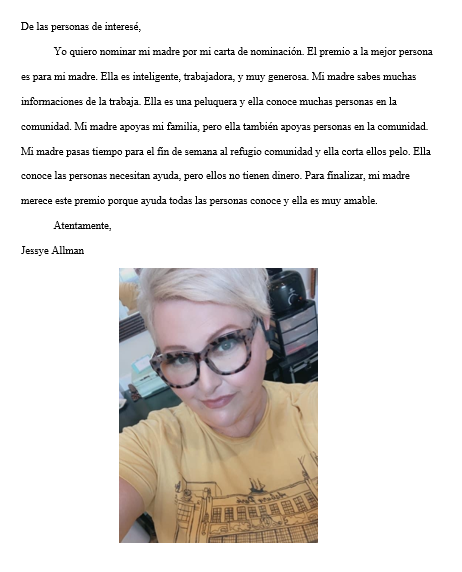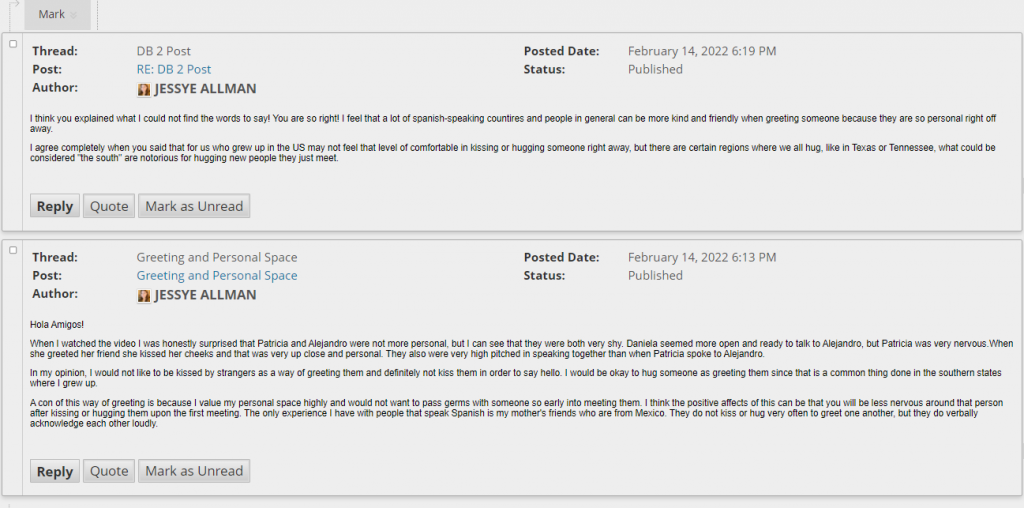Interpretive, Interpersonal, and Presentational Modes of Communication
Exploring Culture
During the course we participated in activities in the Lingro Learning program that exposed us to different cultures and countries in South America. This was a Presentational Mode of Communication and helped me gain understanding of certain cultural practices. The examples given were from individual citizen in those specific countries and just how different their every day lives can be from ours in America.
A major take away from exploring the cultures of Spanish-speaking countries, for me, was that in America we do not have a great understanding of how differently these countries have developed and celebrate differently. I learned that our holidays are not the same and there are many more community events in these Spanish-speaking countries like Spain and Mexico than we have on our calendars. All of the cultural exploration modules in Lingro Learning helped me to better understand these holidays and events by pushing me to research them on my own using Spanish words and phrases online and report back what I found. This was exceptionally interesting and informative.
Engaging in Communities
Getting involved in your own community can be overwhelming at first, but once you have a place to be together with those who you can call neighbors, there are many new doors that can open for you and your family. There is so much value in becoming an active member in your community, such as: finding others that share your interests, gaining support and care from neighbors when it is needed, and even being able to give yourself a sense of purpose in helping your neighbors. On a global perspective, a great way to get involved is to learn the language and cultures of others’ communities and be an advocate for those who may not speak the native language of your state or region.
This semester, in Spanish 101F, we engaged a lot in our class together as students. We worked together to produce projects and complete assignments in our discussion board. This proved to be very important during the course because we were able to compare our knowledge and gain a better understanding of each module as a class.
Below, I have attached a photo of my classmates and I participating in a discussion board assignment. It outlines a reflection of our favorite holidays in other countries.

Interpersonal Communication
For Spanish 101F, we used oral and audio activities in the Lingro Learning program that helped enhance our ability to pronounce and hear certain terms in Spanish. We were graded on how well we speak phrases, ability to pronunciate complicated words, and conjugating verbs while speaking in sentences.

Learning the pronunciations with the vocabulary videos were an easy way to help me learn to speak Spanish, but what really aided my learning was being able to speak Spanish and record my voice and pronouncing words. It was difficult at first because I did not trust that I was saying the correct words or phrases. I was very nervous to hear myself, but eventually I became excited to see what I would sound like in a new language. This allowed me to hear where I needed improvement and successfully perfect the way I speak certain phrases. I could then record again and understand why this was sounded correct and remember how it was pronounced. This proved to be very effective and helpful to my learning Spanish. I have grown tremendously in gathering sentences and rolling my “R” sound with certain terms.
Presentational Speaking
In Span101, we used a lot of interactional speaking to practice and learn speaking Spanish words and phrases. This mode of communication proved difficult because I was very nervous in the beginning. I did not want to make mistakes in front of my classmates and that made me practice even more on my own outside of class. We used videos to record having short conversations about what we learned in each lesson.
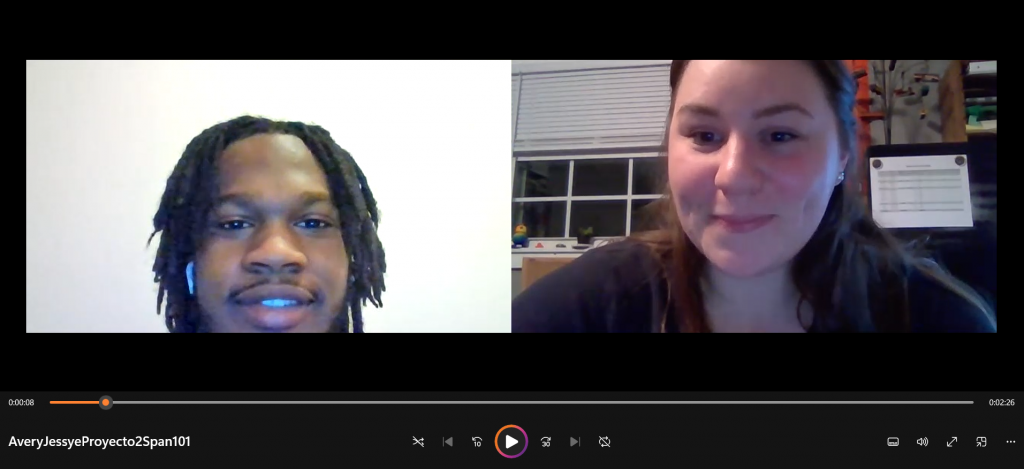
Above is a photo of one video we performed this semester in Spanish 101f. We created four videos with our partners in this class and doing so really helped us connect to our peers. In the first video, we spoke basic phrases about our ages, how we were doing, where we are from, and what major we selected at our university. There were a lot of challenges throughout the process, but the most challenging thing for me was using the phrases and words we conjugated in real life sentences. I mean to say that I had trouble putting together phrases and words into sentences instead of saying them individually. I have since learned to do this by practicing everyday and making sure that I use those sentences in my daily life. I also utilized the provided applications on my computer and sites that help me study. I remembered to use Spanish first rather than translating them back from English- this has helped with my remembering words.
Presentational Writing
I completed a nomination letter for my class peers to read about my favorite person. This letter was composed of only Spanish along with a photo of that favorite person and I am very proud of how it turned out.
We also used various Discussion Board posts to show our presentational writing and below you will see an example of this writing.
This semester, I really enjoyed writing in Spanish and learning how to use different verbs in each context. I learned so much about accents and why they make meaning for certain words versus another word or phrase. At first, it was difficult for me to conjugate verbs because I had trouble deciding which ending went with each type of verb. For example, the -IR verbs have irregular ending when using “yo.” However, I was able to overcome this by repeating to myself those forms and practicing out loud with my peers via video chat. I excelled at pronounciation when it came to certain words. It really came natural to me that “a” sounds like “ah” and in some words the “e” will sound like “eh.” I believe, next time I will want to study more in person with someone who speaks spanish, so that I can better understand what I am pronouncing wrong and what I can change to improve my sentence structuring.
Interpretive Listening
In the Lingro Learning program, we participated in listening activities to enhance our understand of Spanish words pronounced by Spanish-speaking persons. We listened to phrases and sentences spoken and then we chose which answer corresponded to the audio. Below, you will see an example of this activity that I completed.
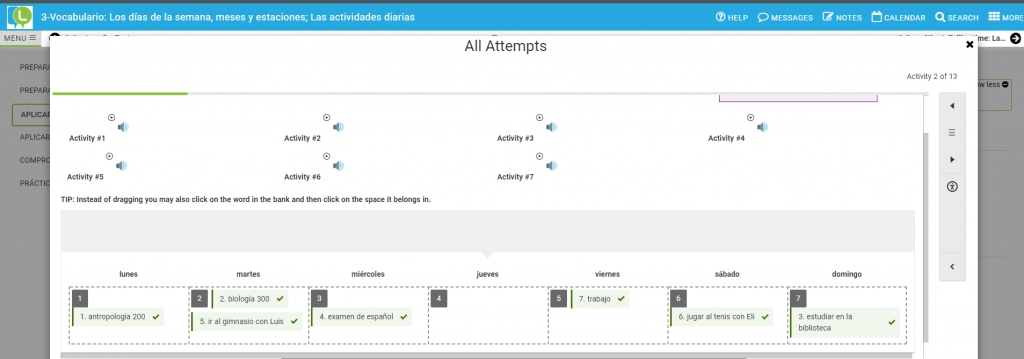
This activity really enhanced my ability to listen to Spanish words and phrases because it forced me to really try to understand what was being said and which words were being used. Also, I was able to hear certain accents and rolling of the “r” for certain ones. There was a distinct learning in this because it helped me to retain more information from hearing it verus reading the words then trying to say them without examples. I really enjoyed these activities because I felt that I learned so much from them and retained more information.
Interpretive Reading
In Spanish101f, we learned about reading and interpreting schedules. We participated in several activities where we had to find certain events and times on someone’s schedule.
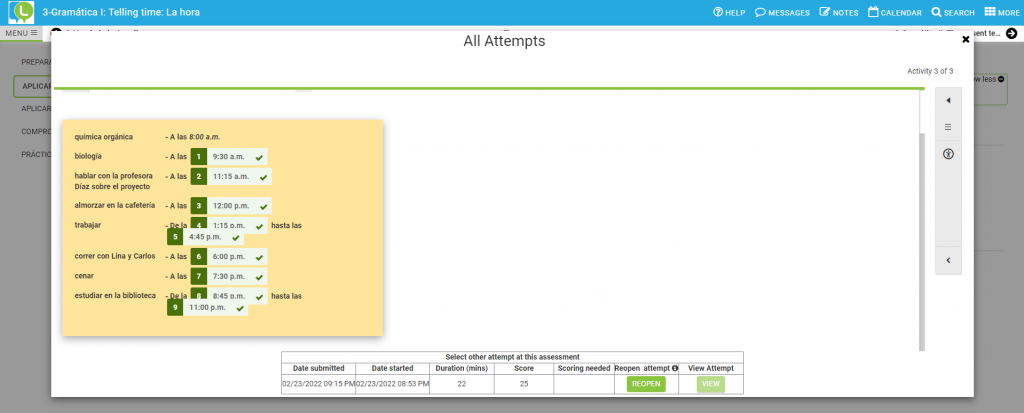
In one activity, we read this article about why learning to speak Spanish is a great idea for not only our class expectations, but also our future careers. This was very helpful due to the many reason Spanish has proven to be helpful in my every day interactions outside of my home and community. I feel that I have grown comfortable enough to order food at a Spanish restaurant, have a brief conversation about my surroundings, and even discuss school events with my peers and neighbors.
